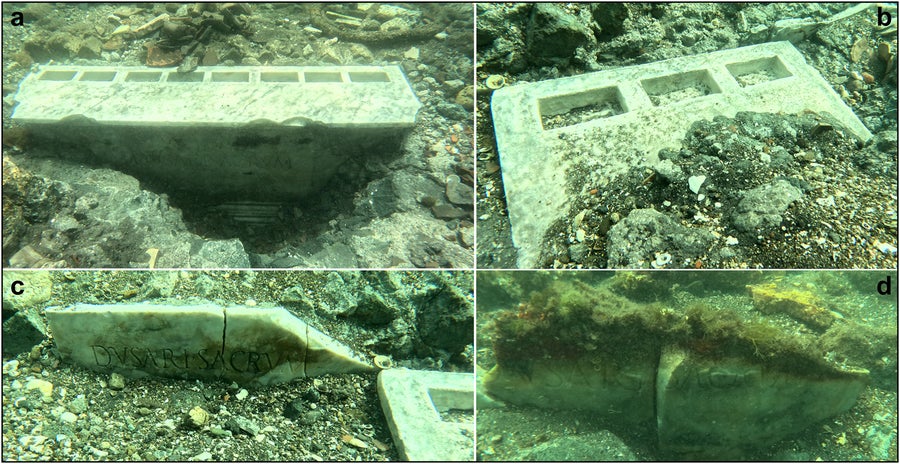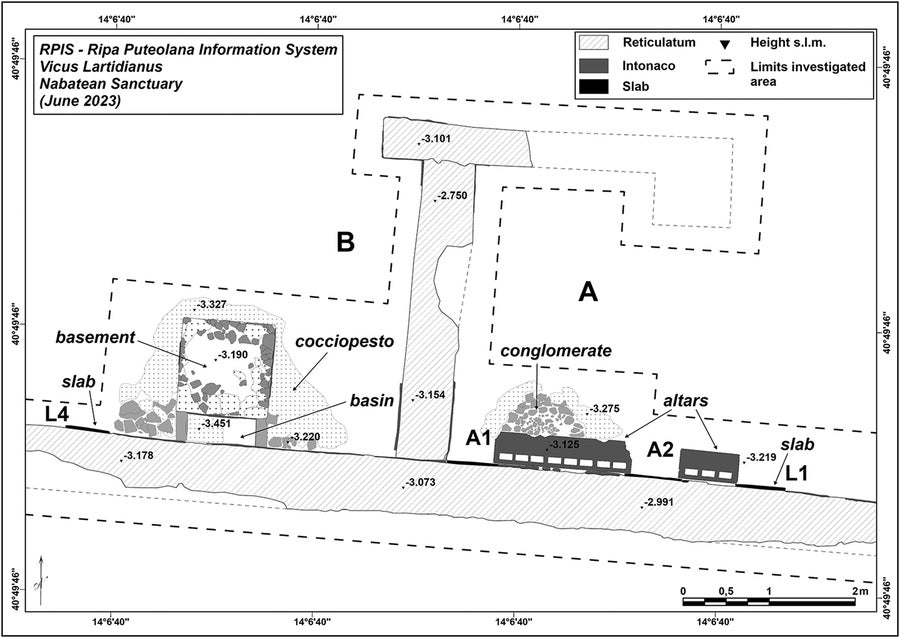October 29, 2024
4 min learn
Sunken Temple of Historical Arabian Civilization Discovered off Italy
An historical temple made by Arabian immigrants from the Nabataean tradition has lastly been discovered off the Italian coast
The submerged historical warehouse district alongside the Pozzuoli coast.
Archaeologists have found historical altars and inscribed marble slabs submerged alongside the Italian coast close to Naples. The finds are probably the stays of a 2,000-year-old temple constructed by immigrants from Nabataea, an historical kingdom on the Arabian Peninsula whose rock-carved “Treasury” featured in “Indiana Jones and the Final Campaign.”
Nonetheless, the flowery temple was later buried with a mixture of concrete and damaged pottery, probably as a result of overseas merchants leaving the realm, in response to a research printed Sept. 12 within the journal Antiquity.
“For me this was some of the sudden discoveries,” research first creator Michele Stefanile, a maritime archaeologist on the Southern Graduate Faculty (Scuola Superiore Meridionale), an schooling institute in Naples, advised Reside Science in an e-mail.
On supporting science journalism
For those who’re having fun with this text, contemplate supporting our award-winning journalism by subscribing. By buying a subscription you might be serving to to make sure the way forward for impactful tales concerning the discoveries and concepts shaping our world right this moment.
The temple sits off the coast of Pozzuoli, a city within the volcanic Campi Flegrei, about 10 miles (16 kilometers) east of Naples. In Roman instances, town was often known as Puteoli and was a big harbor the place ships from all around the Roman world docked to usher in commerce items like grain.
Volcanic exercise over the centuries has considerably modified the shoreline at Pozzuoli, submerging and preserving round 1.2 miles (2 km) of Roman-era warehouses and different buildings related to the traditional port district. Artifacts recovered from the ocean way back to the 18th century recommended that there was a buried temple, however nobody knew precisely the place.

Examples of the altars and inscribed marble slabs discovered off the coast of Pozzuoli, Italy.
In 2023, researchers mapping the area’s seafloor found two submerged rooms with Roman-style partitions. These partitions, which measured about 32 toes by 16 toes (10 by 5 meters), made up two giant rooms. Two altars of white marble had been leaning in opposition to the wall of 1 room. Each altars included a number of rectangular recesses, which most likely as soon as housed sacred stones. Every of the rooms additionally contained a marble slab with the Latin inscription “Dusari sacrum,” that means “consecrated to Dushara,” the primary god within the historical Nabataean faith.
“Plainly we now have a constructing devoted to the Nabataean gods, however with Roman structure and Latin inscription,” Stefanile stated.
The Nabataean Kingdom reached from northern Arabia to the japanese Mediterranean. Within the fourth to second centuries B.C., the Nabataeans managed a rising commerce community of luxurious items equivalent to incense, gold, ivory and perfumes, accumulating large wealth by the late first century A.D. The large tomb usually known as The Treasury on the Nabataean capital of Petra was constructed round that point.

The archaeologists’ map of their excavation of the Nabataean temple.
“It makes good sense that the Nabataeans could be in Puteoli as a neighborhood of merchants,” Steven Tuck, a Roman historian at Miami College in Ohio who was not concerned within the research, advised Reside Science in an e-mail. Puteoli was the second-largest metropolis and the primary harbor of Roman Italy on the time, Tuck stated, and the “Nabataeans would have been drawn there and introduced their non secular practices with them.”
Laurent Tholbecq, an archaeologist at Université libre de Bruxelles, advised Reside Science in an e-mail that “it’s not shocking to discover a temple to Dushara/Dusares, their major divinity,” at Puteoli. “It’s extensively understood that the Nabataeans benefitted from the Roman advance within the Close to East till the creation of the Arabian province underneath Trajan,” a Roman emperor who dominated from A.D. 98 to 117, stated Tholbecq, who was not concerned within the research.
After Nabataea was annexed into the Roman Empire in A.D. 106, the tradition’s management over the inland caravan commerce in Arabia collapsed. The destruction of the temple at Puteoli might replicate that turbulent time.
Stefanile and his group found that the temple was purposefully buried within the second century A.D. with a mixture of concrete and damaged pottery.
“Presumably after Trajan’s conquest of Arabia in 106 A.D., the Nabataeans had no extra chance of free buying and selling in Puteoli, they usually probably deserted the harbor,” Stefanile stated.
Copyright 2024 Reside Science, a Future firm. All rights reserved. This materials might not be printed, broadcast, rewritten or redistributed.



/cdn.vox-cdn.com/uploads/chorus_asset/file/25699314/ESPN_Football_Island_02.png?w=150&resize=150,150&ssl=1)

